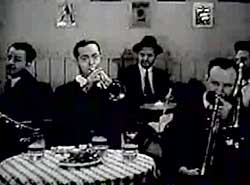 Linda Keene backed up by a solid little jazz band sings Frankie & Johnny (1941), a three-minute jukebox soundie.
Linda Keene backed up by a solid little jazz band sings Frankie & Johnny (1941), a three-minute jukebox soundie.
The setting is a jazz club & Linda sits alone at a table playing solitaire as she begins the song. The band is seated at another checker-tableclothed table.
The film cuts to a dance sequence of a seedy Frankie & Johnny, played by the dance team of "Moore & Revel." This obscure adagio dancers had a brief fame in the mid-1930s as regulars at the popular cabaret Casa Manana, noted for spoofing the Rogers & Astair style of romantic dancing.
They also appear in the Vitaphone two-reel musical Cure it with Music (1935); a comedy starring Cary Grant & Nancy Lane The Thirty Day Princess (1934); & the variety show sequence in the Spencer Tracy mystery The Murder Man (1934).
By the time they got the very minor soundie gig, their star was already fading, but they're obvious charmers in this. Their danced romance is interupted by a showgirl Nelly Bly, who makes Frankie mad enough to murder Johnny. Johnny's exaggerated dance of death is a riot.
It all ends with a long instrumental by the Henry Levine Dixieland Band, with Levine playing trumpet.
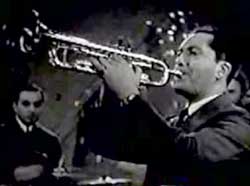 Pretty, dark-haired, & talented Linda Keene sings another wonderful tune backed up by Dr. Henry "Hot Lips" Levine & his Dixieland Jazz Band, in the three-minute soundie When My Sugar Walks Down the Street (1942) whereon "all the birdies go tweet tweet tweet." Pretty, dark-haired, & talented Linda Keene sings another wonderful tune backed up by Dr. Henry "Hot Lips" Levine & his Dixieland Jazz Band, in the three-minute soundie When My Sugar Walks Down the Street (1942) whereon "all the birdies go tweet tweet tweet."
The setting is again a jazz club. There's a group of four choras line dancers. We get to see a bit of them back stage as well as on the dance floor.
Keene & Levine's final soundie is Ja-Da (1942), which opens with Levine's band performing in graduation gowns, Doc Hot Lips having gruffly & quickly scatted "Jadda-jadda-jing-jing-jing" to get it going.
 It then cuts to a group of student dancers in the park-like environment of the college grounds. Linda appears singing: It then cuts to a group of student dancers in the park-like environment of the college grounds. Linda appears singing:
"Jadda. Jadda. Jadda-jadda-jing-jing-jing/ That's a funny little bit of melody/ It's so soothing & appealing to me."
We'll get a good look at clarinetist Larry Shields before it's over, a musician whom Benny Goodman acknowledged as an influence.
It cuts to an interior scene of an elderly group singing & dancing to "Ja-Da," then cuts to hospital surgical room in which Doc Hot Lips cures the patient by singing "Ja-Da," then picks up his horn as Nurse Linda comes in to finish off the tune. Charming.
Keene's really talented & it's too bad she never really broke out of the greater horde of singers to become a big star. She took her name from the Ginger Rogers' character in Shall We Dance (1937).
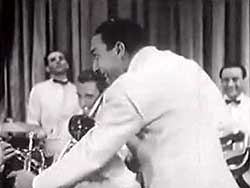 Joseph Matthews "Wingy" Manone & his Mardi Gras Band star in the jukebox soundie The Saints Come Marching In (1943), conveying fresh enthusiasm for an old New Orleans standard. Joseph Matthews "Wingy" Manone & his Mardi Gras Band star in the jukebox soundie The Saints Come Marching In (1943), conveying fresh enthusiasm for an old New Orleans standard.
Wingy's career spanned half a century. He's still a big & unforgotten name among Dixieland jazz devottees, but he's not much remembered in general, fame being a fragile thing that survives the grave by chance more than by merit.
Wingy has a wonderful face, especially in profile, a burly guy who could easily have gotten work as a bouncer, with a bit of an Igor hunch, a thrilling disposition, & a trumpet. When he starts singing, it's pure magic.
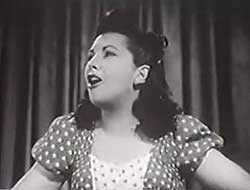 As Wingy plays that trumpet it's hard to tell at first glance that his right arm is missing, severed in New Orleans in a street car accident when he was ten, hence the name "Wingy." As Wingy plays that trumpet it's hard to tell at first glance that his right arm is missing, severed in New Orleans in a street car accident when he was ten, hence the name "Wingy."
On stage he manipulated his prosthetic arm just enough to keep the lack from being noticeable.
Wingy & his band also perform for the soundie Vine Street Blues (1943) with guest singer Ann Lee.
Wingy's trumpet & Jerry Waled's clarinet get solos, then outcomes Ann dancing & singing together with Wingy.
Given the high-oxtaine thrills generated by Wingy, Ann might easily have come off lightweight by comparison, but no, she totally holds her own belting out the number, with some great gutteral scatting thrown in. She'd be performing with Wingy pretty much the rest of his & her career.
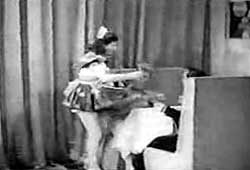 Wingy with his Mardi Gras Band backs up Carol Adams on Juke Box Joe's (1944). It's a rapid upbeat novelty number with fun lyrics such as: "Rooty tooty duty, cut a rug/ With a country cutie, jitterbug."
Wingy with his Mardi Gras Band backs up Carol Adams on Juke Box Joe's (1944). It's a rapid upbeat novelty number with fun lyrics such as: "Rooty tooty duty, cut a rug/ With a country cutie, jitterbug."
Carol is all decked out like a carhop waitress though the stage is set up as an indoor cafe, which is of course Jukebox Joe's. While singing the tune, Carol delivers an order to a table, to diners who are already practically dancing in their seats.
Momentarily the clientelle are up & dancing. These are the Carol Adams Dancers. Two of the couples are Lenny Smith & Freda Angela Wyckoff, & Gil & Nikki Brady, who are also to be encountered dancing in the films Untamed Youth (1957) & Twice Blessed (1945), plus the soundie has a third couple unnamed, possibly Hal & Betty Takier. They are jitterbugging all over the joint, with Carol tapdancing in their midst.
Carol seems to be forgotten now, but she'd been in showbiz from age five, in the silent era, when she appeared in Hal Roach Our Gang comedies. As a teenager she was on the vaudeville circuit. In the 1930s & 1940s she played bit roles in sundry films that needed a good dancer. In Shirley Temple movies, it's often Carol's tapdancing that is being heard on the soundtrack. She was still a leading tapdance star in the 1940s.
Juke Box Joe's is a pretty thrilling soundie, or "dancie" as the case may be, but it would've been much better if we'd actually seen Wingy performing.
copyright © by Paghat the Ratgirl
|
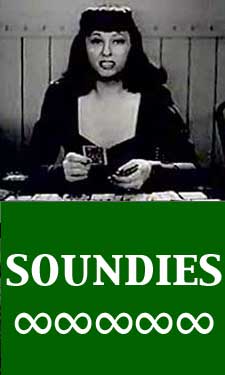


 It then cuts to a group of student dancers in the park-like environment of the college grounds. Linda appears singing:
It then cuts to a group of student dancers in the park-like environment of the college grounds. Linda appears singing:
 As Wingy plays that trumpet it's hard to tell at first glance that his right arm is missing, severed in New Orleans in a street car accident when he was ten, hence the name "Wingy."
As Wingy plays that trumpet it's hard to tell at first glance that his right arm is missing, severed in New Orleans in a street car accident when he was ten, hence the name "Wingy."